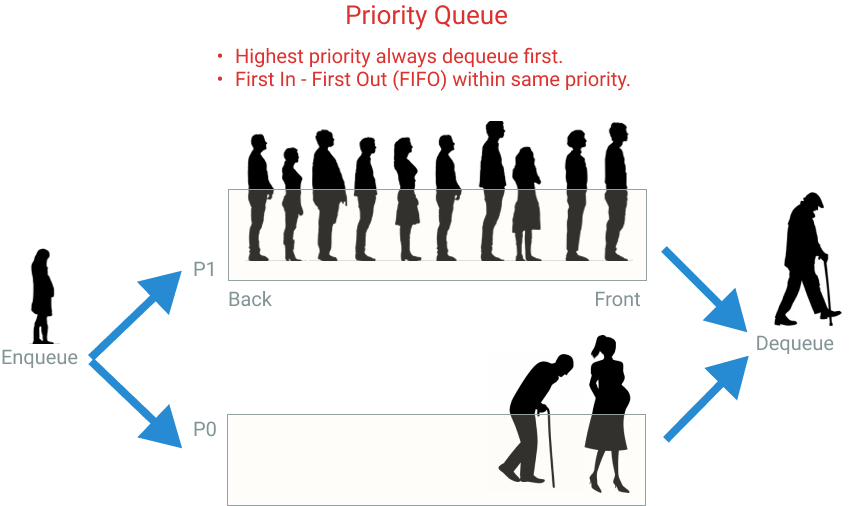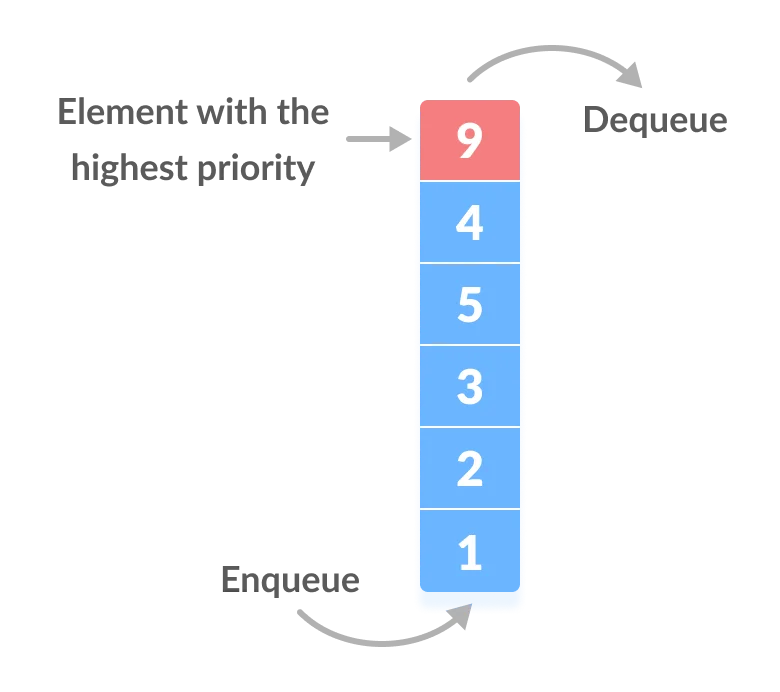Priority Queue
Priority queue is a data structure that extends the queue data structure with a priority dimension. Queue is a list of elements taken in the same order as they arrived. For instance, a line of people waiting to pay at the Supermarket behaves like a queue: first-in, first-served, or FIFO (first in, first out).
Priority queue adds a priority to each element’s value. If we go back to the example of a line of people in a supermarket. You can add preferred lanes, for example, Seniors (65+ years old) and pregnant women. If you have Seniors in the line, you will take them first, even if other people arrived before them. That’s what a priority queue (PQ) does. If all elements in a PQ have the same priority, then it will behave like a regular queue.

Applications of Priority Queue
There are many real-world applications for priority queues, such as:
- System to triage hospital patients and attend them by their severity order.
- Forward network packages in order of urgency (e.g., “real-time video call” should go before “time sync checks,” so to speak)
- Scheduling tasks in a system: “critical” goes before “shadow drawing” for instance.
- Asynchronous control flows like firing events (or notifying observers) in a certain order.
- Keeping track of top k elements efficiently
- Keeping track of median numbers in constant time
- Used in some graph algorithms like Dijkstra for finding the shortest path between two points. The distance among points is used as a priority.
Implementations
- Let’s explore several possibilities for data structures we could use to implement a priority queue:
- Unordered array
A simple, yet inefficient implementation, as retrieving the max element would require searching the entire array.
- Sorted array
This is not a very efficient implementation either. Inserting a new element requires linearly searching the array for the correct position. Removing similarly requires a linear time: the rest of the elements need to be adjusted (shifted) into correct positions.
- Hash table
Although inserting into a hash table takes constant time (given a good hash function), finding the max element takes linear time. Therefore, this would be a poor choice for the underlying data structure.
- Heap
It turns out that that a heap makes an efficient priority queue.
- Unordered array
| Operation | Unordered array | Sorted array | Hash table | Binary heap |
|---|---|---|---|---|
|
insert |
|
|
|
|
|
maxElement |
|
|
|
|
|
removeMaxElement |
|
|
|
|
public class MyPriorityQueueWithArray {
private int count = 0;
private int capacity = 10;
private PriorityNode[] elements = new PriorityNode[capacity];
public void enqueue(PriorityNode node) {
if (node == null || node.getData() == null) {
return;
}
System.out.println("node: " + node.toString());
System.out.println("count: " + count);
int position = 0;
if (count == 0) {
/**
* tail has the highest priority
*/
elements[position] = node;
} else {
PriorityNode highestNode = elements[position];
while (highestNode != null && node.getPriority() <= highestNode.getPriority()) {
position++;
highestNode = elements[position];
}
add(node, position);
}
System.out.println("insert position: " + position);
System.out.println("\n");
count++;
}
private void add(PriorityNode node, int position) {
if (count == capacity) {
/*
* when full, double its size
*/
capacity = capacity * 2;
}
PriorityNode[] temp = new PriorityNode[capacity];
int index = 0;
int lastIndex = count + 1;
while (index < lastIndex) {
if (index < position) {
/**
* front
*/
temp[index] = elements[index];
} else if (index == position) {
/**
* middle
*/
temp[position] = node;
} else {
/**
* back
*/
temp[index] = elements[index - 1];
}
index++;
}
elements = temp;
}
public PriorityNode removeAt(int position) {
PriorityNode[] temp = new PriorityNode[capacity];
PriorityNode removedNode = elements[position];
int index = 0;
int lastIndex = count + 1;
while (index < lastIndex) {
if (index < position) {
/**
* front
*/
System.out.println("front");
temp[index] = elements[index];
} else if (index == position) {
/**
* middle
*/
System.out.println("middle");
} else {
/**
* back
*/
System.out.println("back");
temp[index - 1] = elements[index];
}
if (temp[index] != null)
System.out.println("temp: " + temp[index].toString());
index++;
System.out.println("\n");
}
elements = temp;
return removedNode;
}
/**
* Retrieves, but does not remove, the head of this queue, or returns null if this queue is empty.
*/
public PriorityNode peek() {
return elements[0];
}
/**
* Retrieves and removes the head of this queue, or returns null if this queue is empty.
*/
public PriorityNode dequeue() {
return removeAt(0);
}
public void print() {
int index = 0;
PriorityNode node = elements[0];
while (node != null && count > index) {
System.out.println((index + 1) + ". " + node.toString());
index++;
node = elements[index];
}
}
}
